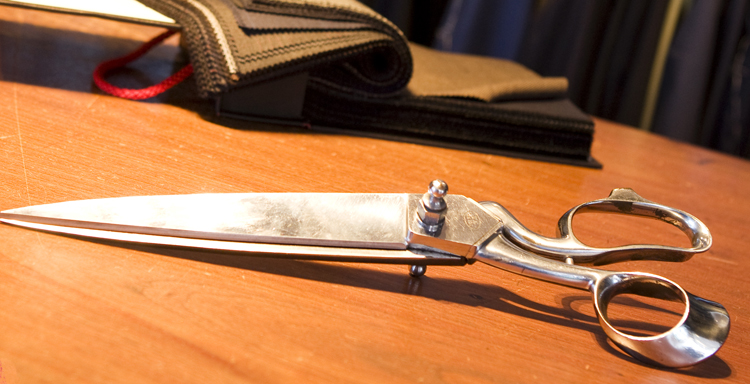Tailor
The OED has the current meaning dating from 1297 – the word is based on an Old French word, meaning “cutter”, but by the beginning of the 14th century the meaning was already as it is today, and tailoring guilds were protecting their members’ interests.
With the appearance of wealth towards the end of the middle ages, the tailor’s task of assembling garments to provide warmth and protection had started to morph into providing adornment and enhancement. Fashion was born, and the skill-set was rapidly expanded.
The farmer, the shepherd, the weaver and the tailor all worked to bring clothing to the market, but as the last point in the chain, the tailor become the more influential and eventually exceeded the importance of the weaver. The tailor was required to understand the fine points of all the other crafts to ensure that the right cloth was delivered to him, and the profession became even more complex and specialised.
Fashion takes on a life of its own
The Renaissance flourished in continental Europe first: Italy, France, Spain, Holland all became centres of fashion as the cities and states vied with each other for economic and artistic mastery. Elsewhere only the very wealthiest could afford to ape the manners and dress of the merchant classes of Venice, Florence and Amsterdam.
Tailors' Art
A great flowering of fashion peaked in France with the reign of Louis XIV, The Sun King, when wealthy men and women from all over Europe, including Britain, came to Paris for their clothes. Figures of fun to their non-fashionable contemporaries, the powdered and be-beauty-patched dandies, with long flowing wigs and tightly-cut brocade coats were testaments to their tailors’ art.
Impractical to most, the doublet, hose and cloak gave way to waistcoat, breeches and coat and not long after the Sun King’s death in 1715 the focus of fashion had moved away. Across the Channel in London, the embroidered fop had a short life, and in the Puritan environment that followed the Civil War such ostentation was frowned upon. The Restoration in 1660 brightened things up again, but by 1715 the Stuarts were out, Orange had been and gone, and the German House of Hanover had assumed the task of providing the United Kingdom a King.
Sobriety and practicality became the order of the day, and both the land-owning class and the merchant class had by the early 19th century adopted relatively plain clothing. Only military men in uniform wore gorgeous clothing.
The London Tailor
The ascendancy of empire meant the ascendancy of the London Tailor, and the prevailing taste for practical clothing that could pass muster in society, at sporting occasions (newly fashionable amongst the gentry and the other classes), and through the ordinary day of business affairs.
Cut and Fit
Instead of differentiation in terms of colour and ostentatious cloth, the question of cut and fit became pre-eminent, and the era of the tailor as vice-arbiter of fashion was born. The famous Beau Brummell, arrogant leader of fashion during much of the Regency during George III’s incapacity, patronised Mr Weston, in Conduit St, and affected to despise the tailor, Mr Stulze, favoured by military men such as the Duke of Wellington. Brummell could spot a Stulze coat at 50 paces, and this was enough to set him off on one of his famous cutting tirades: “Give me a man who makes the Tailor, not the Tailor who makes the man.” Everyone else of course relied on the tailor to make the man, as probably did Brummell, but only he had the brass neck to try to carry it off.
(Brummell’s tongue got him into deep water later, when he loudly referred to the Prince Regent, within his hearing, as a companion’s “fat friend”, but that is another story).
New Aesthetic
The London tailor used English woollen cloth and used cutting and reinforcing techniques to selectively stiffen and support. A new modern aesthetic had arrived, with understated enhancement of the body’s natural shape, and the tailor’s skill being devoted to eliminating imperfection and displaying perfection of cut.
Modern technology has brought better spinning, weaving and even sewing. Mass-production to feed mass-consumption has allowed the ready-made industry to achieve reasonable approximations for the average range of body sizes at low prices, and even the mass-produced jacket is no longer made of hard shiny fluorescent fabric. Made-to-measure – the assembling of mass pre-cut patterns of roughly the right size and then fitting on to the person – is a half-way house, but loses all the science of the cut, and usually limits the client in terms of style and cloth.
Art vs Technology: Art Wins!
No amount of automation however can replace the art of the tailor in taking the right cloth, cutting it to the right shape, sewing it with the right tension and strength, to suit the right purpose and making it look right on the right person.
Tailoring is still an art, an art founded in medieval times when only the well-to-do could afford to have someone else make their clothes. In that respect, little has changed – today’s tailor’s client is still typically well-off enough to indulge himself in clothes that truly fit, that are smart and comfortable at once. There is still a need for the uniquely personal and individual that can’t be satisfied by the shapeless ready-made or the shoddy made-to-measure.
Bespoke
And for the client who wants something different, the bespoke tailor, (for he is the highest exponent of the art), is the person to consult; and he will be as excited by the prospect of creating something new and different as the client.
